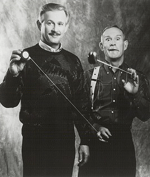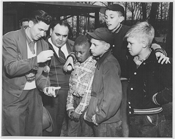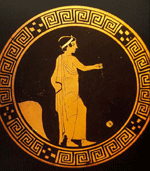When Was
-
The Yo-Yo Invented?
By Mike McLeod
Consider
the humble yo-yo. It’s
just a toy, a plaything.
But this inconsequential
kid’s pastime actually
dates from antiquity.
No
one knows the exact
origins of the yo-yo,
but some believe it
was invented in China.
No one really has any
evidence of that; however,
there is hard evidence
that the ancient Greeks
invented and played
with yo-yos. In the
National Museum of Athens
resides an urn with
a picture depicting
a child dangling a yo-yo
by the string. (Can’t
tell from the urn if
the Greeks knew how
to “walk the dog” or
“rock the cradle.”)
In addition, the museum
has an example of a
terra cotta yo-yo—which
is a stroke of marketing
genius! A toy that is
just made to be broken.
Greek mothers must have
been out buying new
terra cotta yo-yos every
day.
Actually,
Greek children had wooden
and metal yo-yos, too.
So why the terra cotta
version? As a rite of
passage, children offered
their toys to a chosen
god when they came of
age, so the terra cotta
yo-yos may have been
offerings to the gods.
Image that—the humble
yo-yo, an offering to
a god.
Yo-yos
were played with by
the Romans, Indians
(of India and possibly
the Mayans), Egyptians,
English, Scots, Filipinos,
French (including Napoleon’s
armies and King Louis
XVII*) and probably
many others. The first
hard copy record of
the yo-yo in the United
States was a patent
issued in 1866 to James
L. Haven and Charles
Hittrick of Cincinnati
for an improved yo-yo
with added weight.
The
yo-yo was first mass
produced and marketed
in the U.S. by Pedro
Flores, an American
of Filipino ancestry.
He eventually built
factories that reported
made 300,000 yo-yos
per day. The humble
yo-yo had made it to
the big time.
Enter
Donald Duncan, Sr.,
entrepreneur extraordinaire.
After seeing a crowd
gather to watch a demonstration
of yo-yo tricks, he
eventually went to work
for Pedro Flores. A
couple of years later,
Duncan purchased the
company $250,000 in
the early 1930s.
The
toy that was first patented
in 1866 under the name
whirlygig, Duncan patented
it in 1932 as the yo-yo,
the name Flores had
originally christened
it. Duncan took his
product on the road
and had youthful experts
showing kids across
America how to do yo-yo
tricks. By 1946, the
Duncan Company was making
millions of yo-yos per
year, and in 1962, he
sold more yo-yos (45
million) than there
were kids in America.
Today,
the name Duncan Yo-Yos
is owned by Flambeau
Plastics. But because
the Supreme Court ruled
in a lawsuit that the
term yo-yo is now generic,
any manufacturer can
use that name.
So
the humble yo-yo, with
its ancient Greek or
possibly Chinese beginning,
has traveled the world,
amazed the armies of
Napoleon and visited
the Supreme Court. Kind
of gives you more respect
for this little toy
on a string, doesn’t
it?
*A
1789 painting shows
King Louis XVII of France
as a child playing with
a yo-yo. He died in
1795 at the age of 10
from tuberculosis.
|

Tommy
Smothers
was a
true
follow of
“Yo,” as
he
termed
it, and
showed his
skills here
in 1988.

Several
companies
jumped
on
the yo-yo
bandwagon.
In
this
1954 promotional
photo, Cheerios
Demonstrator
Barney Ryan
wows some
yo-yo fans.

Painting
on a Greek
urn of
a
boy and
his
yo-yo.
Photos,
courtesy
of owner
David Hall
and www.yoyomuseum.com.
|